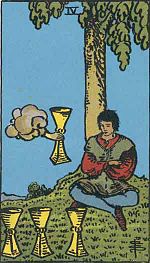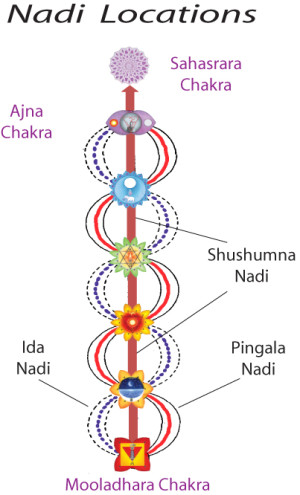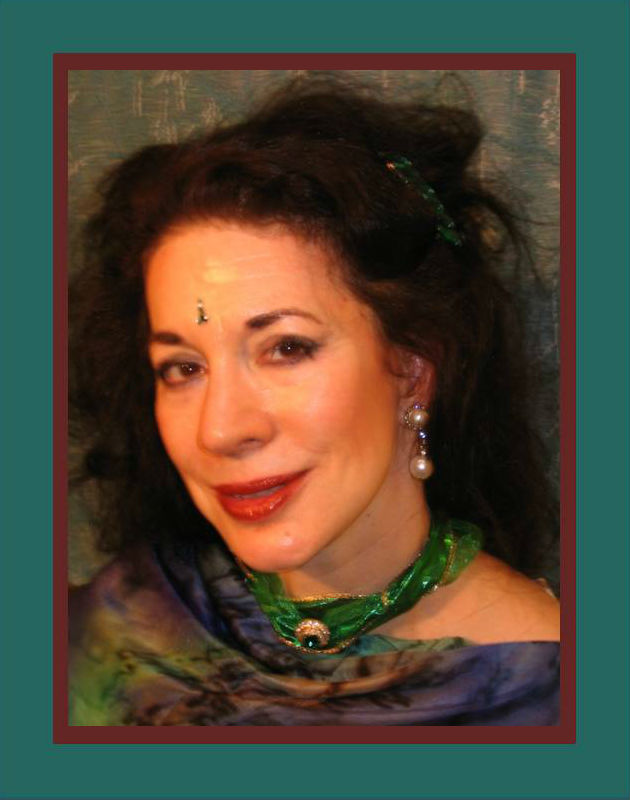Autumn Lesson 4 in The Season of Cups: Moving Out of Stuck Situations
The primary focus of this ten-week series (from the Ace through the Ten of Cups) is on cultivating our internal energy and bringing it up our spines. The final stage of this series is actually the Ace of Cups, when we (supposedly) learn to “fountain” our energy around ourselves.
This is an important goal, both because being able to “fountain” our energy (actually, to do anything at all with our internal energy) is good, but also because this ability is a crucial predecessor to the really important energy exercises:
- The Micro-Cosmic Orbit (a Taoist energy practice),
- The Middle Pillar (a western esoteric energy practice), and
- The Circulating the Body of Light (both western and eastern).
We will be doing the first two of these practices (Micro-Cosmic Orbit and Middle Pillar) over the winter, and the final one (Circulating the Body of Light) in the summer.
What we are doing now, though, is a structured energy practice that will lead us steadily to some of these more advanced exercises.
In the previous three weeks, we introduced the Season of Cups and basic exercises for this autumn quarter:
- Week One: Energy Dancing with a Water Feeling,
- Week Two: Filling Our Energy Well Using Circular, Flowing, and Snake Movements with the Chifti Telli Rhythm in Esoteric Belly Dance, introducing our Ida/Pingala energy channels, and
- Week Three: Autumn Lesson 3: Unifying Our Vital Energies, tracing Ida/Pingala up the spine along with the Sushumna primary channel.
In this Autumn Week 4, we encounter emotional blocks that keep us from fully doing our energy work.

Learn more about the Tarot’s Minor Arcana Four of Cups.
The Four of Cups is a moment of stasis; we are so locked up in our present thoughts and conditions that we can’t open up to new “good energy” that is being offered to us.

When we studied the Two of Cups, we realized that we were being directed to examine the Ida/Pingala energy streams at the root of our spine. At the Three of Cups, we included the Sushumna primary energy column in our attention, and did the first “interweaving” or “crossing over” of the Ida/Pingala streams. We did this at an energy nexus point on our spines that connects directly to the second chakra in front.
(Recall our energy anatomy: there are six “nexus points” on the spine, each of which connects via nerve bundles to one of each of six nerve ganglia on our fronts. Each of these physical nerve ganglia bundles corresponds to a chakra area.)
Now, at the Four of Cups, we’re at the second crossing of the Ida/Pingala streams, which corresponds to the third nerve bundle on the spine and the third nerve ganglia grouping and chakra center on our fronts.
This third chakra occurs at our solar plexus. This is right where our upper diaphragm (the one separating our heart and our lungs from our abdominal organs) occurs.
When we are energetically and emotionally blocked or “stuck,” then our diaphragm is tight, and we have a rigid hold on the muscles in our upper abdominal area as well as our sternums. The result is that we have a tight and rigid dance.
In Unveiling: The Inner Journey, I describe how one of my master teachers, Anahid Sofian, corrected me and another leading dancer on precisely this matter.
Across the crowded floor, a series of young women swayed like seaweed in the ocean. Their eyes on the diminutive teacher, they followed Anahid Sofian in her graceful yet precise movements…
“Leah,” she called out to a dancer, “you need to release – right here.” She gestured to her own sternum. We were practicing upper body undulations, one of the most beautiful and sensual moves in Oriental dance. “And Alay’nya,” she turned, scrutinizing me, “you need to do the same.”
Both Leah and I were well beyond the beginner’s level. … Here we were, getting the same correction on one of the most basic moves. “What,” I wondered, “is going on with us?”
Suddenly it hit me; one of those “Aha!” moments. Leah and I both epitomized the “young-woman-on-her-own-in-the-world.” Having to make it on our own in essentially a man’s world, we had taken on the masculine attributes of body armor by using our muscles and ligaments! By stiffening our muscles, and holding them tightly, we created an impenetrable shield; we were “armored” against the world. What we were doing in our bodies reflected more the influence of Athena, Goddess of Intellect (as well as war; she is the ultimate Amazon), than Aphrodite, the Goddess of Love. We were fully in our Amazon mode!
Releasing the muscles in our sternum took conscious attention from each of us. It did then, and it still does. The old tension patterns die hard. [from Unveiling: The Inner Journey, Chapter 14, “Locking Our Minds Out of Our Bodies,” pp. 189-190]
For many of us, as we go into the autumnal Season of Cups, our attention is not just on practicing technique. Rather, it becomes a quest to release those tensions and blockage patterns that keep the movement from flowing freely.
Here’s to your own “inner un-blocking”!
Very best wishes as you use Oriental dance (belly dance) for personal growth and healing!
Yours in dance –

Alay’nya
Author of Unveiling: The Inner Journey
You are the Jewel in the Heart of the Lotus. Become the Jewel!
Founder and Artistic Director, The Alay’nya Studio
Bellydance a courtesan would envy!
Check out Alay’nya’s YouTube Channel
Connect with Alay’nya on Facebook
Follow Unveiling: The Inner Journey on Facebook
P.S. Getting Your Own Copy of Unveiling: The Inner Journey
Do you want to continue reading Chapter 14, from which the beginning was excerpted above? You can have your print copy of Unveiling overnight from Amazon, or a Kindle version within minutes.
|
Alay’nya, Unveiling: The Inner Journey |
||||
|
Paper
|
Kindle
|
|||
P.P.S. More Unveiling
A very important related section is in Chapter 9, “The Essence of Stillness.” I have a nice long extract posted on the Unveiling website. Go to the Resources page, and look for the extract about Esther. Also, you’ll have a chance to sign up for the Unveiling e-newsletter, and be given early information on:
- Workshops: Whether my own, or those that I highly recommend (and will likely attend), be the among the first to know your options for putting your Unveiling studies into practice – topics will range from archetypal to dance to the “Fountain of Youth,”
- Best-of-the-Best links and “insider info,“ which I custom-select, carefully edit, and share just with the Unveiling Community (free, but you must Opt-In using the Opt-In form on the website’s first page) and
- Weekly updates – so that you won’t miss a thing!

Very best wishes to you make your dances more fluid and expressive as you add “water play” to your practice!
Yours in dance –
Alay’nya
Author of Unveiling: The Inner Journey
You are the Jewel in the Heart of the Lotus. Become the Jewel!
From Dr. Nicole Cutts’ Amazon review of “Unveiling: The Inner Journey”: “I love, love, love this book! It is like the g*ddess mother, mentor I never had and always needed. Finally a book that just tells it like it is for women. It is well written, intelligent and enlightening. For any woman who wants to live a life of adventure,joy and love. It is rich with so much wisdom and grounded in thorough research, which I love! I can’t say enough about it. All I can say is read it if you are looking for something new to take you to the next level of womanhood.”







